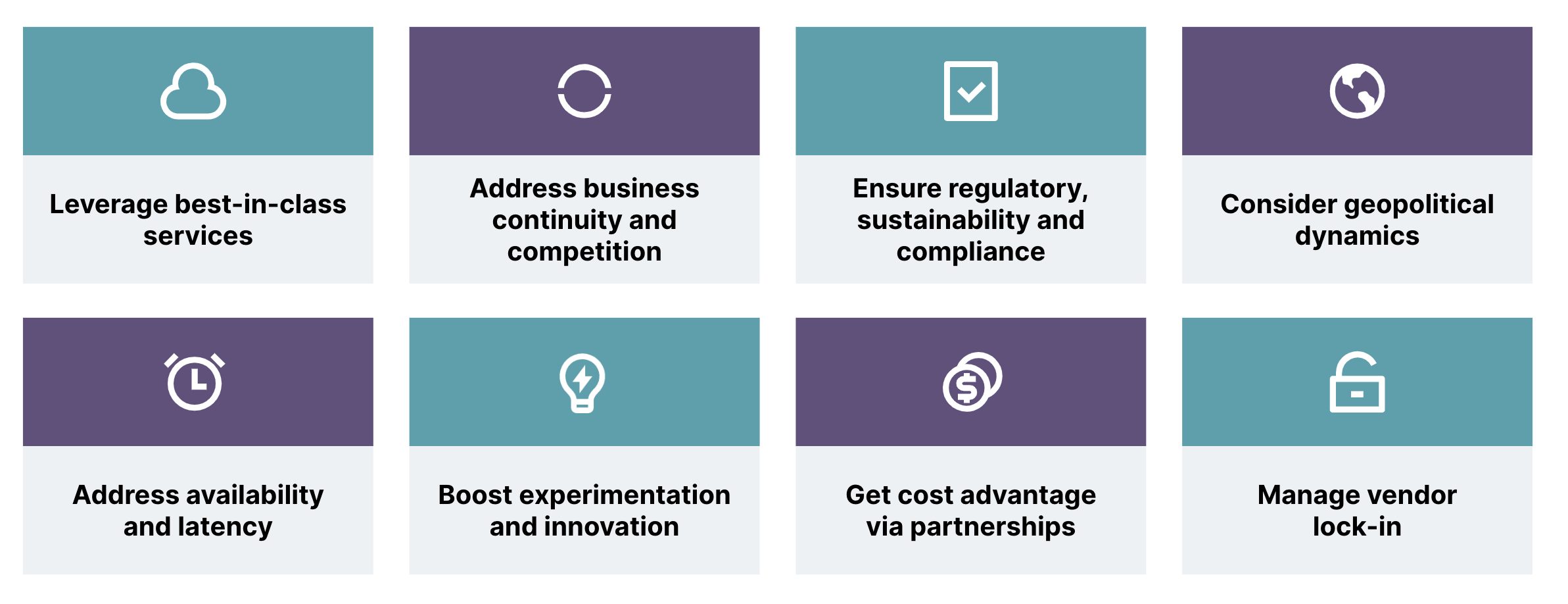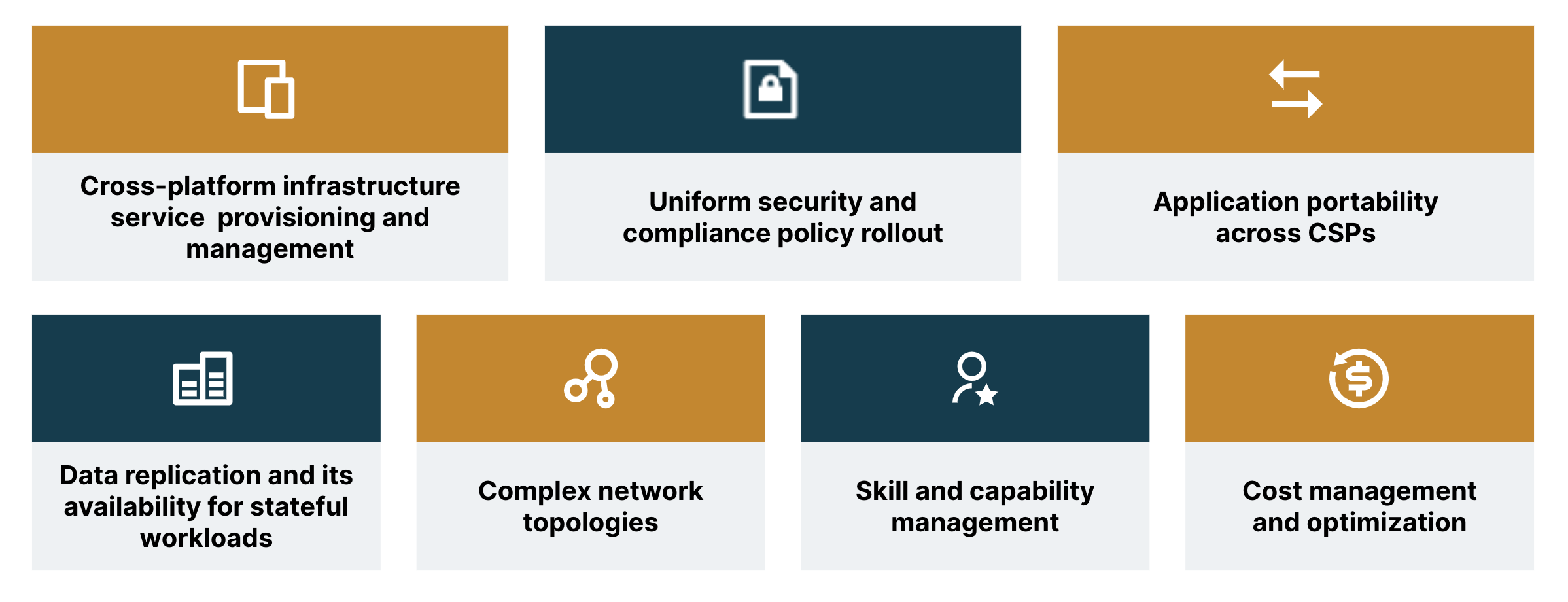In an earlier blog, we covered a high-level overview of cloud strategies - from mono-cloud to distributed cloud implementation. In this article, we list the reasons large enterprises should consider multicloud in their overall cloud strategy and discuss the business drivers that support the approach.


Leverage best-in-class services
Cloud Service Providers (CSPs) are creating specialized services to differentiate themselves, for example, AWS Textract and Google Document AI to focus on structured form data extraction, Amazon Comprehend Medical to extract health data from medical text and so on. Applications leverage these specialized best-in-class services through a polycloud strategy to choose the right technology for a purpose which leads to expected business outcomes in a shorter time to market.
Address business continuity and competition
Many financial institutions have a disaster recovery set-up on another CSP as a part of regulatory compliance to ensure business continuity in case of natural disasters. Sometimes, enterprises explore a multicloud strategy to ensure resilience via failover across multiple CSPs (mostly in active-passive mode across CSPs).
Sometimes, the move from one CSP to another is fueled by a conflict of interest or competition. Many eCommerce companies decide to move from AWS to GCP or Azure due to a direct conflict of interest with the Amazon retail marketplace.
Ensure regulatory and sustainability compliance
Many countries have local data residency requirements leading to CSPs with local availability zones (AZs), or a limited choice of CSPs. For example, as of January 2022, AWS is not available in Switzerland. Therefore, to address the data residency law of Switzerland, the most likely choices for companies would be Azure or GCP.
The world is moving toward green initiatives and sustainable business practices. Many large organizations aim to reduce their carbon footprint, so choosing a CSP, with lower cloud carbon emission can be a criterion for enterprises.
Consider geo-political dynamics
All CSPs are working on expanding their global footprint. Geopolitical considerations play an important role in the multicloud strategy. For example, as a part of the digital silk road initiative, China is aiming to put one million new companies on the cloud and sign an agreement with Egypt, Laos, Saudi Arabia, Thailand, Turkey and UAE in order to lead the global market. The cloud business becomes geopolitics-driven as increased investments in land for building data centers in regions and new AZs are established. As this geopolitical war of tech dominance intensifies between China and US-based tech companies, multinational companies need to consider a multicloud operating model for their business across geographies.
Address service availability and network latency
Not all regions have multiple AZs for setting up disaster-recovery sites. Also, all cloud services provided by the CSP may not be available in all regions and availability zones. For example, in India, AWS had only one availability zone (Mumbai) for a long time and Hyderabad AZ was added in 2020. Until 2019, EKS was not available in AWS Mumbai (India) region. Many companies therefore considered GCP for containerized workloads.
Another critical aspect is network latency. In the US, accessing sites hosted in the East coast from the West adds up latency. For applications having low latency requirements like streaming, booking cab rides, or stock trading, choosing the right CSP helps reduce latency.
Boost experimentation and innovation
Digitally native companies or startups frequently invest in next-gen Proof-Of-Concepts (PoC) and want to launch new products or preview features faster to market. It enables them to quickly churn a business idea into production and get rapid customer feedback. In such cases, choosing the relevant services from a CSP provides a quick start. For example, AWS EMR allows experimenting with ML workloads while leveraging the best open-source tooling in the space.
Get a cost advantage via partnerships
Different CSPs offer discounted multi-year contracts to move workloads from on-premise to the cloud or for implementing specific programs on the cloud. Companies may decide to take advantage of such price lists and move workloads across CSPs. For example, CSP provides far more competitive rates when enterprises give a commitment of multi million dollar business in a year with multi-year contracts. CSPs also provide promotions for companies willing to do joint public announcements of moving to a cloud and sharing how enterprises are leveraging cloud services.
Manage vendor lock-in
Enterprises explore multicloud strategies to reduce over dependence on a single CSP. Workload portability is a focal point while considering cloud architecture patterns to avoid vendor lock-in or manage it with minimal efforts. While cloud-agnostic architecture gives complete control and flexibility to enterprises, the tradeoff may result in more efforts and costs.
Considerations in adopting a multicloud strategy
There are obvious considerations when adopting a multicloud strategy – starting with a better understanding of what the business is signing up for when embarking on this journey. We discuss other considerations given the complexity across the landscape and desired impact.


Cross-platform infrastructure service provisioning and management
Managing services across CSPs within a single pane-of-glass view becomes more difficult. Many tools available in the market claim to do it. However, CSPs are launching new services and variations at rapid speed and it is impossible for the tools to keep up. Enterprises need to invest in specialists or experts and have the right policies and guidelines in place to reap the benefits of multicloud and leverage best-in-class services from each CSP. Otherwise, the multicloud infrastructure services management may result in the wastage of resources.
Infrastructure service provisioning gets more complicated as automation tooling (like CloudFormation from AWS) is CSP-specific. Cloud-agnostic tools like Terraform have matured over the last few years. However, certain CSP specific aspects are still better managed by CSP-provided tools.
Also, observability and monitoring must be considered for cross-platform management. The choice of observability architecture patterns depends on data sensitivity (that must stay on-premises) and the preference to use any CSP-specific tool or the need for centralized monitoring.
Uniform security and compliance policy rollout
Each CSP has a distinct security model that requires significant effort to develop common security policies and compliance implementations, with the risk of user errors and data breaches. Following ‘The Principle of Least Privilege’ is key for security and compliance. However, implementing it across CSPs is a challenge.
Application portability across CSPs
Nowadays, Kubernetes provides a cloud-agnostic workload deployment layer, which makes application portability across CSPs easier (also referred as 'higher-order infrastructure'). However, the usage of serverless architecture and SaaS services for quick turnaround time makes cloud portability daunting. On the other hand, opting for an always on cloud-agnostic architecture is costly and effort-intensive. It is advisable to invest in libraries and frameworks that provide an abstraction layer (anti-corruption layer) to avoid lock-ins.
Data replication and its availability for stateful workloads
Sharding, sharing and replicating data across CSPs is the tricky part of cloud architecture implementation and requires considerable time and effort. For example, database sharding or Kafa replication across CSPs requires application architectural feasibility and complex changes. One area of concern is latency in sharing data from one CSP to another and relying on an eventual consistency model. Moreover, the cost of moving data from one CSP to another is considerable, as all incoming or outgoing data is charged by each CSP.
Complex network topologies
A secure network setup is one of the most complex pieces of the overall cloud setup. With multicloud, it gets even more complex and needs special tooling for traffic management, such as ingress traffic (a.k.a North-South traffic) and egress internal traffic (a.k.a. East-West traffic).
Large enterprises leverage CDNs, such as Cloudflare as a single point of entry to manage incoming traffic across CSPs and provide edge protection. The CSPs are only connected to CDN with no direct public access, which reduces surface area for entry.
Skill and capability management
Your cloud team would typically have roles, such as cloud architects, cloud SMEs, engineers, DevOps / infra consultants, site reliability engineers (SREs) and managers. In the post-pandemic world, companies are increasing their digital transformation spend and IT services vendors are coming up with ambitious hiring plans. In these talent wars, building in-house capabilities or hiring them from the market is time-consuming and risky. Moreover, doing this for multiple CSPs may look like a constantly moving goalpost. The best way to handle it is to find the right balance of generalists with cloud-agnostic tools, techniques and skills, along with specialists with deep expertise in each CSP.
Cost management and optimization
With multicloud, cost and complexity are bound to rise. Organizations end up managing and running infrastructures at multiple ends with multiple CSPs. Capability building, partnership and vendor management, regulatory and compliance efforts also increase multifold. For example, choosing a tech stack for observability and monitoring across CSPs needs to be cross-platform, which increases setup, maintenance and running cost.
Multicloud challenges mapped with effort and complexity
Multicloud challenges |
Associated Efforts |
Associated Complexity |
Cross-platform infrastructure service provisioning and management |
↑↑ | ↑ |
Uniform security and compliance policy rollout |
↑ | ↑↑ |
Application portability across CSPs |
↑↑ | ↑ |
Data replication and availability for stateful workloads |
↑ | ↑↑↑ |
Complex network topologies |
↑ | ↑↑ |
Skill and capability management |
↑↑↑ | ↑ |
Cost management and optimization |
↑ | ↑ |
Before adopting multicloud strategies, it is essential to weigh the cost, complexity and challenges to the overall infrastructure space. Multicloud strategy should be defined and adopted at the organizational level, with backing from all business units and functions. The strategy fails when each function or business unit has a different cloud adoption strategy rather than an organizational strategy.
Disclaimer: The statements and opinions expressed in this article are those of the author(s) and do not necessarily reflect the positions of Thoughtworks.


















